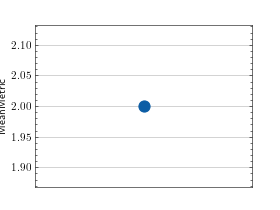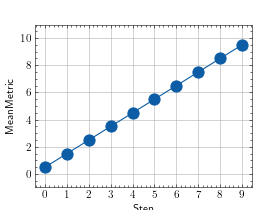Mean¶
Module Interface¶
- class torchmetrics.aggregation.MeanMetric(nan_strategy='warn', **kwargs)[source]¶
Aggregate a stream of value into their mean value.
As input to
forwardandupdatethe metric accepts the following inputvalue(floatorTensor): a single float or an tensor of float values with arbitrary shape(...,).weight(floatorTensor): a single float or an tensor of float value with arbitrary shape(...,). Needs to be broadcastable with the shape ofvaluetensor.
As output of forward and compute the metric returns the following output
agg(Tensor): scalar float tensor with aggregated (weighted) mean over all inputs received
- Parameters:
nan_strategy¶ (
Union[Literal['error','warn','ignore','disable'],float]) – options: -'error': if any nan values are encountered will give a RuntimeError -'warn': if any nan values are encountered will give a warning and continue -'ignore': all nan values are silently removed -'disable': disable all nan checks - a float: if a float is provided will impute any nan values with this valuekwargs¶ (
Any) – Additional keyword arguments, see Advanced metric settings for more info.
- Raises:
ValueError – If
nan_strategyis not one oferror,warn,ignore,disableor a float
Example
>>> from torchmetrics.aggregation import MeanMetric >>> metric = MeanMetric() >>> metric.update(1) >>> metric.update(torch.tensor([2, 3])) >>> metric.compute() tensor(2.)
- plot(val=None, ax=None)[source]¶
Plot a single or multiple values from the metric.
- Parameters:
val¶ (
Union[Tensor,Sequence[Tensor],None]) – Either a single result from calling metric.forward or metric.compute or a list of these results. If no value is provided, will automatically call metric.compute and plot that result.ax¶ (
Optional[Axes]) – An matplotlib axis object. If provided will add plot to that axis
- Return type:
- Returns:
Figure and Axes object
- Raises:
ModuleNotFoundError – If matplotlib is not installed
>>> # Example plotting a single value >>> from torchmetrics.aggregation import MeanMetric >>> metric = MeanMetric() >>> metric.update([1, 2, 3]) >>> fig_, ax_ = metric.plot()

>>> # Example plotting multiple values >>> from torchmetrics.aggregation import MeanMetric >>> metric = MeanMetric() >>> values = [ ] >>> for i in range(10): ... values.append(metric([i, i+1])) >>> fig_, ax_ = metric.plot(values)

